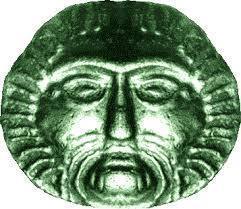
#13 Beltane
Share
Bel from whom Beltane receives its name is also known as Belenus and is one of the most widely worshipped Celtic deities. He is a sun god known as “The Shining God”. Like the Norse Sol he was thought to ride the sun across the sky in a horse drawn chariot. In the 3rd century, Bel was the patron deity of the Italian city of Aquileia. Some ancient images of Belenus show him to be accompanied by the Gaulish Goddess Belisama.
Of the four main Irish celebrations, Beltane and Samhain were the most important. In the story of the “Wooing of Cu Chulainn”, the ancient celebration of Beltane is described. The year is described as being in two divisions of summer from Beltane (the first of May in our modern calendar to Samhain and winter from Samhain to Beltane. At Beltane Druids used to make two fires and made magical incantations as they drove the cattle between them every year. This was to protect the cattle against plagues. The young ox and cows were entrusted to the God Bel, whose protective powers were believed to be in the flames, smoke and ashes of the fires.
The people of ancient Ireland would also walk between the bonfires, and sometimes leap over the flames or embers. People would take embers and re light their home from the Beltane bonfires. They would feast and offer food and drink to the Aes Sídhe. Homes would also be decorated with yellow May flowers. People used morning Beltane dew on their faces to stay young and beautiful. When Christianity arrived, many of these customs and more became part of May Day. Beltane is also a celebration of love and this harks back to the ancient tale of Cú Chulainn and Emer, or the divine pairing of Belenus and Belisama.
Of the four main Irish celebrations, Beltane and Samhain were the most important. In the story of the “Wooing of Cu Chulainn”, the ancient celebration of Beltane is described. The year is described as being in two divisions of summer from Beltane (the first of May in our modern calendar to Samhain and winter from Samhain to Beltane. At Beltane Druids used to make two fires and made magical incantations as they drove the cattle between them every year. This was to protect the cattle against plagues. The young ox and cows were entrusted to the God Bel, whose protective powers were believed to be in the flames, smoke and ashes of the fires.
The people of ancient Ireland would also walk between the bonfires, and sometimes leap over the flames or embers. People would take embers and re light their home from the Beltane bonfires. They would feast and offer food and drink to the Aes Sídhe. Homes would also be decorated with yellow May flowers. People used morning Beltane dew on their faces to stay young and beautiful. When Christianity arrived, many of these customs and more became part of May Day. Beltane is also a celebration of love and this harks back to the ancient tale of Cú Chulainn and Emer, or the divine pairing of Belenus and Belisama.
